Google Play Store Optimization: Ranking Algorithm Revealed (2023)
Like Google search engine, Google Play also use smart algorithms to determine the ranking of an app. Therefore, know the ranking factors and optimize them continuously are important to rank your app or game higher in Google Play.
Though Google hasn’t unveiled the algorithm of Google Play, ASO experts still find clues of most important ranking factors based on their years of experiences.
Compared to Apple App Store, the Google Play algorithm for ranking and search is more complicated.
In the following post, I’m going to share with you top 12 ranking factors for the Google Play Store algorithm.
Contents
- Top 12 Ranking Factors for Google Play Store
- 1. App Name (Title)
- 2. Short Descriptions
- 3. Long Descriptions
- 4. Localize Your Store Listing
- 5. URL / Package
- 6. App Category & Tags
- 7. Ratings and Reviews
- 8. Download Numbers & Velocity
- 9. Android Vitals – Crashes, Bugs, Battery Life & File Size
- 10. Application Updates
- 11. Graphic and Image Assets
- 12. Backlinks
- Conclusion
Top 12 Ranking Factors for Google Play Store
1. App Name (Title)
Your app’s name plays a key role in your app’s ranking. It’s the first thing play store’s search engine takes into account when a user enters a search query.
Usually, we will write App name in this format: Brand Name + Main Keywords.
Including keywords in your app name will improve its visibility in app stores which in turn will perk up your downloading rate and if more people are downloading your app, your app store ranking will significantly improve.
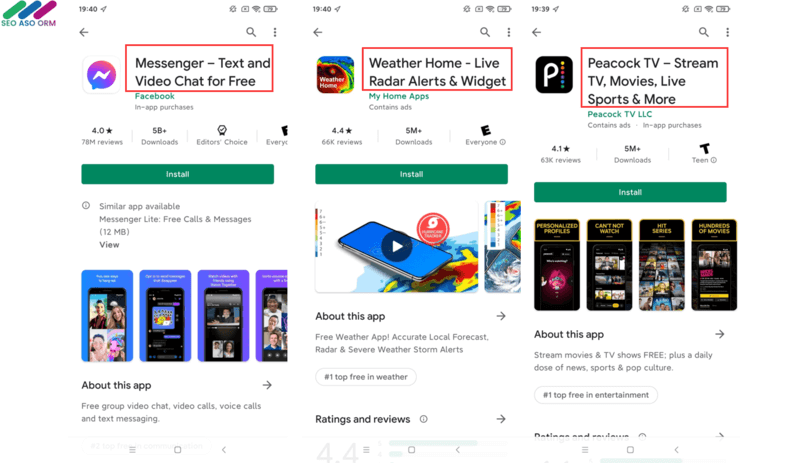
In the new policies, you should limit the length of app titles to 30 characters (previously 50 characters). Also, keywords that imply app store performance, rank, price or promotion in the title, icon and/or developer name are no longer allowed.
Note: As app name plays an important role in keywords rankings, many developers create fake apps that mimic the look and/or functionality of legitimate applications to trick unsuspecting users to install them. And some developers use other apps’ brand names in their title.
For example, when I search for TikTok, I see many fake apps rank higher in Google Play. In order to avoid trademark complaint, most of them only use the name and logo similar to “TikTok”.
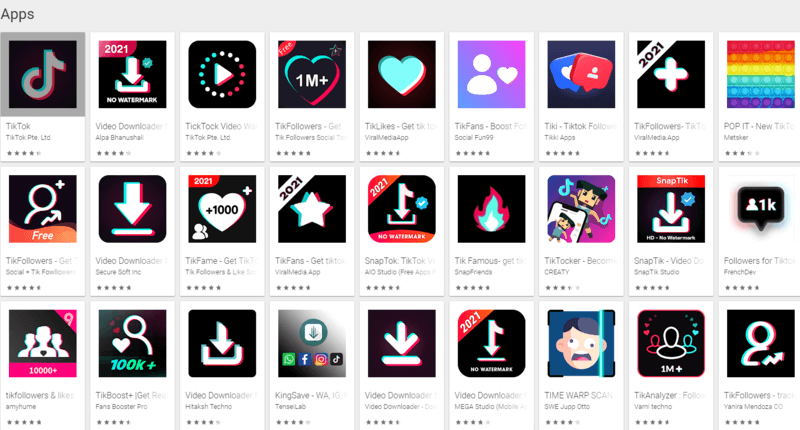
2. Short Descriptions
The short description does not appear in the Google Play Search results, but is visible in the store listing right below the screenshots.
It is a visible element that can convey an important message to potential users. You can summarize the core function or purpose of your app or game in simple and concise language.
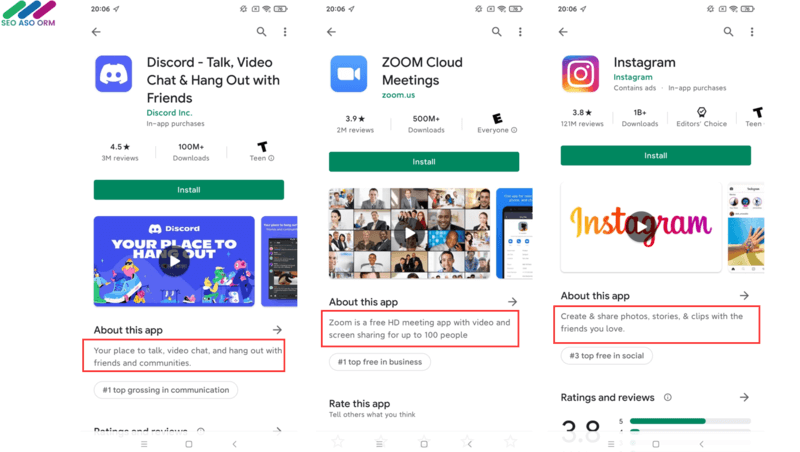
Previously and currently, the short description is also indexed and used by the Google Play search algorithm, so including important keywords in the short description is crucial to optimizing the discoverability of your app.
However, Google says in the new policy, “don’t use unnecessary keywords in an attempt to improve search results; it will not impact ranking and provides a bad user experience.”
In addition, do not use language that is not related to the function or purpose of your app, including:
- Language that reflects or suggests Google Play performance, ranking, accolades or awards, user testimonials, or price and promotional information, for example, “Best,” “#1,” “Top,” “New,” “Discount,” “Sale,” or “Million Downloads.”
- Call-to-actions, for example, “download now,” “install now,” “play now,” or “try now.”
- Do not include special characters, line breaks, emojis, emoticons, repeated punctuation (for example, ?, !!, ?!, !?!, <>, \\, –,***, +_+, …, ((, !!, $%^, ~&~, ~~~), or symbols (for example, ★ or ☆).
3. Long Descriptions
This field is 4000-character long and it is the continuation of your short description. You can use it to provide an extensive, yet clear and structured description of your app’s features and purpose. Google Play allows the use of rich formatting and emojis to make the description more engaging and legible.
Google’s algorithm is going to crawl your whole description looking for keywords. You’d better include your main keywords a few times, especially in the first and last lines of text, to help Google Play rank your app for these keywords, and add some more in the rest of the text. However, be careful with keyword stuffing.
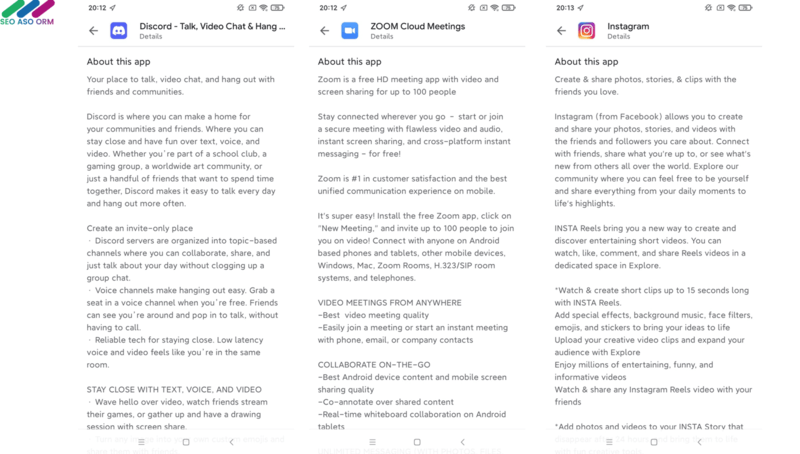
4. Localize Your Store Listing
Google provides automated machine translations of store listings that you don’t explicitly define for your app. That being said, using a professional translation service for your “Description” and “Title” can lead to better search results and discoverability for worldwide users.
Useful guides for app localization:
- App Store Localization for Arabic – Effective ASO Strategies in MENA
- App Store Optimization & Localization for Korea – 10 Winning ASO Tips
- App Store Localization for Japan – Improve CVR & Drive Downloads
- App Store Localization for Taiwan – Best ASO Practices to Drive Downloads
5. URL / Package
As unlikely as it may seem, your application URL or package name is another important element you can use to improve your app store’s indexing and ranking.
Typically, your application URL appears in this format:
(https://play.google.com/store/apps/details?id=package_name )
You can boost your app installs and impressions by including strategic keywords in your package URL.
Here are some interesting indexing elements you can add to your “package name” for extra traffic (with examples included):
- Popular short-tail keywords: Spotify app with the keyword, ‘music’.
(https://play.google.com/store/apps/details?id=com.spotify.music)
- Name of a top competitor: AmongChat leverages Among Us’ popularity.
(https://play.google.com/store/apps/details?id=walkie.talkie.among.us.friends)
- Developer Name: Popular brand names such as Messenger include their name in all their apps’ package names.
(https://play.google.com/store/apps/details?id=com.facebook.orca)
Remember, once your app’s Google Play package URL is published, you can’t modify it. Therefore, you want to pay close attention before hitting the Publish button.
You can choose a category and add tags to your app or game in Play Console. Categories and tags help users to search for and discover the most relevant apps in the Play Store.
If your app easily fits into multiple categories, we suggest choosing the one with less competition. That way your app has a better chance of ranking well in the charts and reaching new users organically.
As for tags, you can add up to 5 tags to your app listing. Google will present you with suggested tags but if you think there are more relevant tags you can choose to search through the list and add the tags that best describe your app or game.
As tags may affect where your app is displayed on Google Play, and the peer groups you’re compared against, it’s important to choose the ones that are most relevant for your app.

7. Ratings and Reviews
Many users rely on reviews and ratings of the app to choose which application to install. Thus, your app should target on having more positive reviews and should include a call to action button for users to leave their comments.
As for Google, it adds a rating filter to Google Play search results to make it easier to search for apps and get actual high-quality listings. With this feature active, users can search for apps or games with filter by star rating. It allows users to only see results that have a 4.0 or 4.5-star rating and above.
The filter urges developers to improve their apps’ ratings to 4.0-start at least. Otherwise, they’ll lose a lot of chance for exposure.
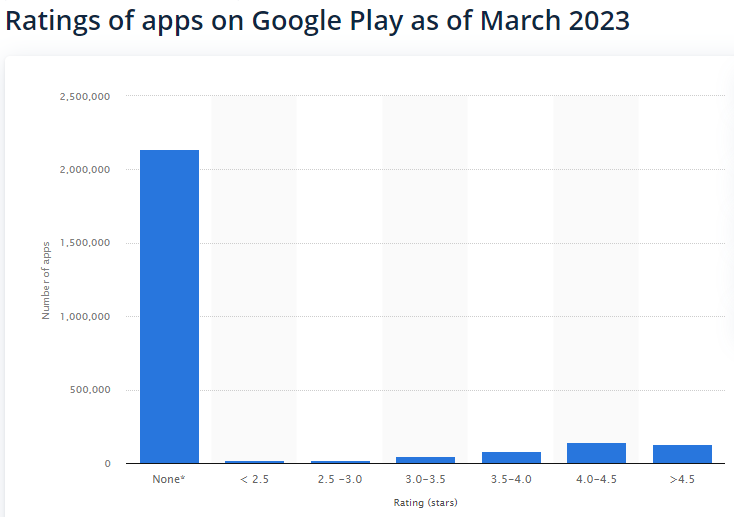
Then, how to improve reviews and ratings in Google Play? Here are some tips for you:
- Build a great app that offers distinct and vital value to the consumers.
- Ask users to rate during true moments of happiness.
- Report and delete spam and fake reviews.
- Use in-app chats to resolve problems before they get posted on the play store. One 1-start rating required 6 5-star ratings to “recover”.
- Actively respond to user feedback. If the user is answered quickly, it will have a positive effect on restoring the score.
- Trigger the in-app review flow after a user has experienced enough of your app or game to provide useful feedback.
8. Download Numbers & Velocity
It may sound obvious, but it’s always good to point out that your app downloads also affect your app store rank. The more downloads and user engagement your app has, the better its rank position will be. The higher rank position is not only in the “top charts”, but also search result.
9. Android Vitals – Crashes, Bugs, Battery Life & File Size
Android vitals is an initiative by Google to improve the stability and performance of Android devices. When an opted-in user runs your app, their Android device logs various metrics, including data about app stability, app startup time, battery usage, render time, and permission denials. The Google Play Console aggregates this data and displays it in the Android vitals dashboard.
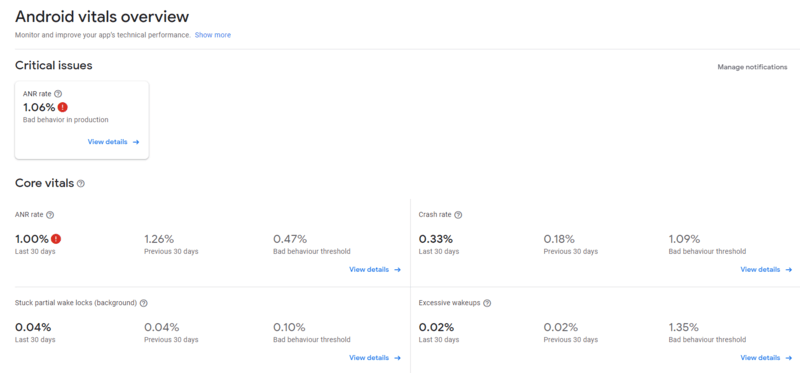
You should pay attention to the crash rate, ANR rate, excessive wakeups, and stuck wake locks. Exhibiting bad behavior in vitals will negatively affect the user experience in your app and is likely to result in bad ratings and poor discoverability on the Play Store.
10. Application Updates
A delay in updating an app could be disastrous in the long run for a developer, as the app might lose current users or alienate those who would have downloaded it.
On average, your app should be updated at least once a month and up to four times in a month to keep its features fresh. Basing updates on the continuous improvement of your users’ experience in the app will keep you relevant.
Then, good user experience leads to good reviews, good ratings and more downloads.
11. Graphic and Image Assets
App icons, feature graphics, and screenshots help make your app stand out in search results, categories, and featured app lists.
These posts may help you optimized your app’s image assets.
- Google Play Feature Graphic Best Practices and 10 Examples
- 2023 App Store and Google Play Screenshot Design Guidelines
12. Backlinks
The final ranking factors we’ll consider is the backlink.
Backlinks are an essential ranking factor that affects SEO. However, as for ASO, backlinks have an extremely minor effect on keyword rankings and will not push an app to the top 10 positions for a competitive keyword.
Anyway, it is good to have many high-quality backlinks that bring the potential users to your app’s Google Play Store page.
Conclusion
Optimization is not a one-day or a one-time activity. It never ends. According to Google:
Apps are ranked based on a combination of ratings, reviews, downloads, and other factors. While the details of these weights and values are a proprietary part of the Google search algorithm, you can work to improve your app’s visibility by:
- Building a lasting and meaningful experience for your users.
- Maintaining and improving your app through regular updates.
- Encouraging users to provide feedback in the form of ratings and comments.
- Providing great customer service by responding to your users and addressing issues.
So, follow the guide in this post and tips from Google to optimize your app or game in Play Store!
